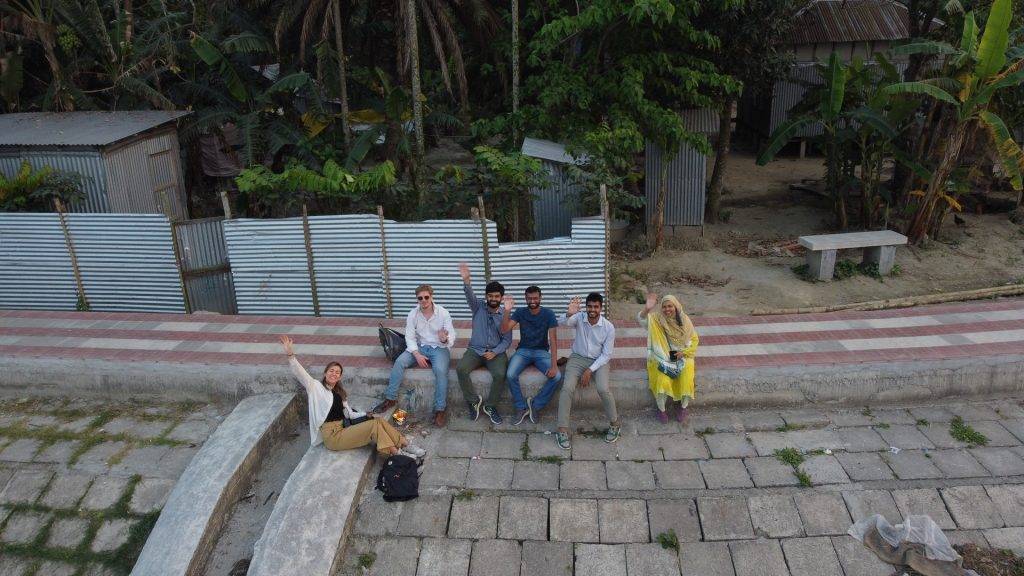Background
Bangladesh’s densely populated landscape is profoundly influenced by its major rivers—the Ganges, Brahmaputra, and Meghna—that form one of the world's largest deltas. These rivers’ dynamic and morphologically active nature results in significant riverbank and coastal erosion, impacting communities, infrastructure, and ecosystems. Erosion, driven by both natural and human activities, leads to land loss, undermines infrastructure, and heightens flood risks. Despite mitigation efforts by the Bangladesh Water Development Board (BWDB), nationwide erosion forecasting remains limited.
BEM Tool
In response, a collaborative project between Bangladesh and the Netherlands is developing the Bangladesh Erosion Monitor (BEM), a tool using satellite imagery to monitor erosion across the country. This initiative, led by Bangladesh's Institute of Water Modelling (IWM) and the Netherlands' Deltares, focuses on equipping BWDB with a data-driven tool for erosion assessment. It emphasizes both technological innovation and capacity building, aiming to enhance risk management in the Ganges-Brahmaputra-Meghna delta region.
MAIN CHARACTERISTICS
- Developed on the Google Earth Engine platform, offering an advanced yet user-friendly tool.
- Validated against riverbank field survey data, proving effective in identifying erosion-prone areas and supporting policy development for managing riverbank erosion and flood hazard across Bangladesh.
- It uses the Landsat-derived Global Surface Water Dataset (GSWD), enabling a comprehensive analysis of river morphology changes across the country from 1984 to 2023.
KEY FUNCTIONALITIES
Historical Erosion Monitoring
The BEM analyses Landsat imagery from 1988 to 2023, enabling users to generate maps that illustrate historical trends in erosion and sediment deposition.
Economic Impact Assessment
The BEM evaluates the economic impact of historical erosion within specified administrative boundaries by integrating ESA WorldCover data with local land value estimates.
Erosion Prediction
The BEM predicts short-term erosion susceptibility by analyzing historical riverbank line data, delivering estimates for every 200-meter segment of the riverbank.
Flood Inundation Mapping
In the event of embankment breaches, the BEM generates flood inundation maps and assesses flood risk by integrating modelled water levels with elevation data.
Action on the Ground
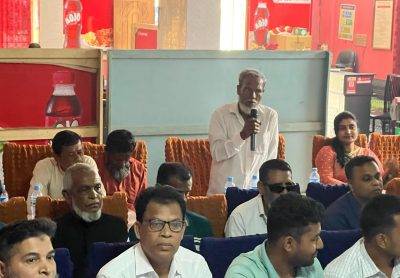 Community members sharing their experiences with erosion during the workshop in Madaripur on March 2, 2024.
Community members sharing their experiences with erosion during the workshop in Madaripur on March 2, 2024.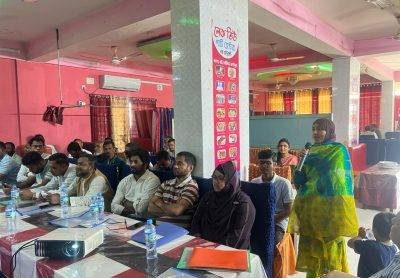 Community members sharing their experiences with erosion during the workshop in Madaripur on March 2, 2024.
Community members sharing their experiences with erosion during the workshop in Madaripur on March 2, 2024. Workshop in Madaripur to share about the BEM tool with community members and hear their experiences with erosion, on March 2, 2024.
Workshop in Madaripur to share about the BEM tool with community members and hear their experiences with erosion, on March 2, 2024. Participants for the workshop in Madaripur on March 2, 2024.
Participants for the workshop in Madaripur on March 2, 2024.
Workshops
A series of workshops have been carried out to inform the community about the tool and to collect feedback regarding the community’s take on river erosion issues. These have highlighted the need for proper planning and timely response regarding riverbank erosion.
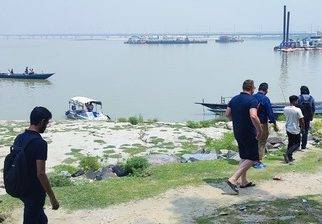 Jamuna River erosion inspection on the left bank south of the Bangabandhu Bridge on May 31, 2023.
Jamuna River erosion inspection on the left bank south of the Bangabandhu Bridge on May 31, 2023. Jamuna River erosion inspection on the left bank south of the Bangabandhu Bridge on May 31, 2023.
Jamuna River erosion inspection on the left bank south of the Bangabandhu Bridge on May 31, 2023. Riverbank protection works on the left bank of the Jamuna River near Tangail on May 31, 2023.
Riverbank protection works on the left bank of the Jamuna River near Tangail on May 31, 2023.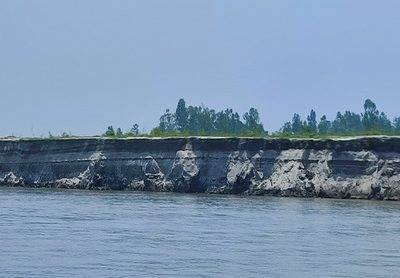 Further erosion on the let bank of the Jamuna River near Tangail on May 31, 2023.
Further erosion on the let bank of the Jamuna River near Tangail on May 31, 2023. Engagement with community members on the Arial Khan River bank on June 1, 2023.
Engagement with community members on the Arial Khan River bank on June 1, 2023.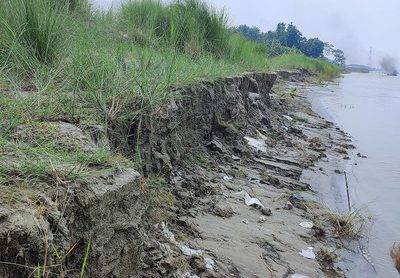 Arial Khan River erosion inspection on the left bank south of the railway bridge on June 1, 2023.
Arial Khan River erosion inspection on the left bank south of the railway bridge on June 1, 2023.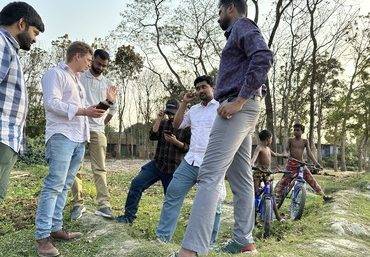 Engagement with community members on the Kumar River near Kabirajpur on March 2, 2024.
Engagement with community members on the Kumar River near Kabirajpur on March 2, 2024.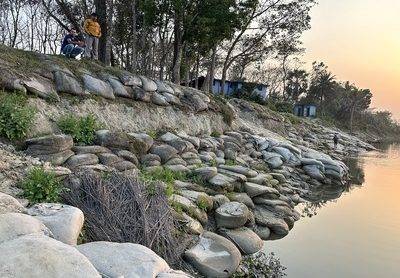 Riverbank protection on eroded bank on the Kumar River near Kabirajpur on March 2, 2024.
Riverbank protection on eroded bank on the Kumar River near Kabirajpur on March 2, 2024.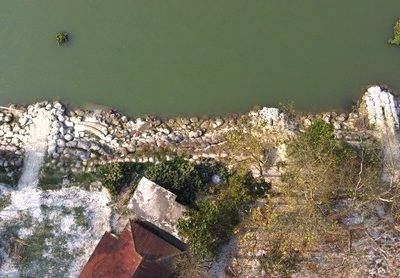 Riverbank protection on Kumar River at Kabirajpur on March 2, 2024.
Riverbank protection on Kumar River at Kabirajpur on March 2, 2024. Kumar River at Kabirajpur on March 2, 2024.
Kumar River at Kabirajpur on March 2, 2024. Riverbank protection on Padma River at Naria on March 3, 2024.
Riverbank protection on Padma River at Naria on March 3, 2024.
Field Validation
Field validation visits were carried out by the joint team of IWM and Deltares in May and June 2023, and March 2024. The team visited different erosion-prone areas where they completed visual inspections and questionnaires for local residents on erosion impacts and community responses. The BEM tool effectively identified areas of erosion and sedimentation, confirming its utility. However, discrepancies were noted in areas where recent BWDB armouring projects had altered the landscape.
 Sprint session in the Netherlands for joint development of the BEM tool in January 2023.
Sprint session in the Netherlands for joint development of the BEM tool in January 2023.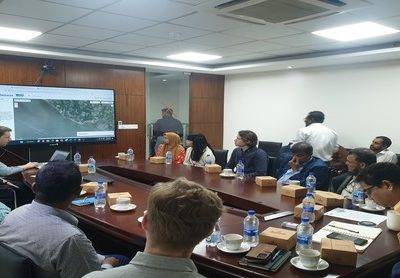 Training for BWDB officials at the Pani Bhaban, the head office of BWDB, in February 2023.
Training for BWDB officials at the Pani Bhaban, the head office of BWDB, in February 2023. Sprint session in Bangladesh for joint development of the BEM tool, in February 2023.
Sprint session in Bangladesh for joint development of the BEM tool, in February 2023.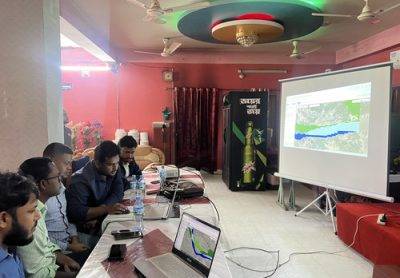 Training for BWDB officials at Madaripur on March 3, 2024.
Training for BWDB officials at Madaripur on March 3, 2024.
Capacity Building
Transfer of knowledge is one of the main objectives of the project. A series of training sessions have been held in Bangladesh and The Netherlands focusing on the use and development of the BEM. Some of the technical people involved in the training include officials from the BWDB Planning, Design, and Flood Forecasting Warnging Center; officials from the BWDB Maradipur field office; and IWM staff.
TESTIMONIES OF COMMUNITY MEMBERS
“The response to riverbank erosion lacks proper planning. The response is based on mostly lobbying, rather than science based.”
– Jahanara Khanom, Primary school teacher, Alipur
“I am rebuilding my home for the seventh time after six of my previous homes eroded away. With the science-based BEM tool, we now can show traces of erosion to the authorities in charge.”
– Alauddin
Sarker, Ex-member, Alipur Village.
“My grandfather had to shift his house 15 times due to erosion and through him I know the sufferings of the people affected by riverbank erosion. I hope the BEM tool would reduce the sufferings of the
community.”
– Lipi Mondal, Primary School Teacher, Dhurail Union
“A famous high school, a renowned madrasa, countless structures of Alipur Village had washed away due to riverbank erosion. I hope through this tool the response of the riverbank erosion will be streamlined.”
– Md Ali, Ex- Army Official, Alipur Village.
Conclusions and Future Developments
The BEM represents a notable advancement in erosion monitoring at a national scale, providing critical insights to support decision-making across applications from infrastructure planning to emergency response. As the project develops, the BEM is expected to contribute to environmental science, risk management, and policy formulation.
Currently optimized for major rivers, the BEM’s 30-meter resolution presents limitations for monitoring smaller rivers. Future enhancements include refining the algorithm with updated Landsat imagery and integrating higher resolution data from Copernicus Sentinel-1 and -2 to increase resolution in smaller watercourses. Additionally, plans to incorporate factors such as soil properties and flow rates aim to improve the accuracy of the erosion prediction module.
